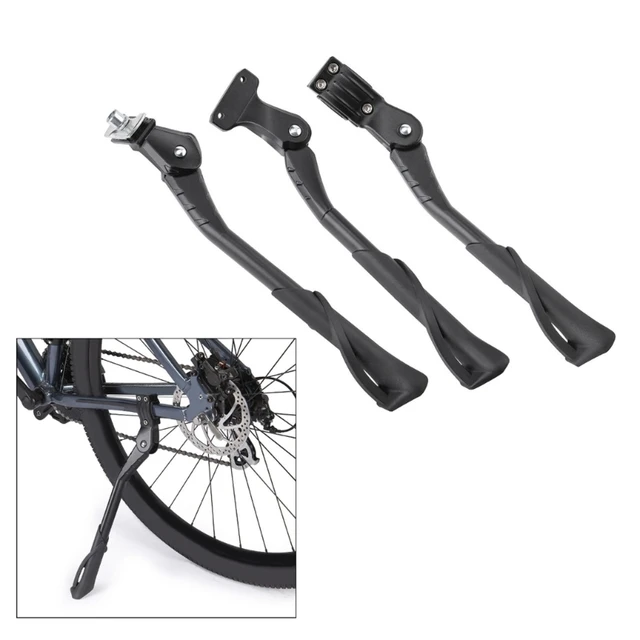Bike Kickstand Review: Everything You Need to Know
Introduction
A Bike Kickstand is an essential accessory for Any rider desiring a convenient way to park their bike without leaning it against a wall or tree. Whether you’re commuting, running errands, or enjoying a leisurely ride, a good kickstand can make a significant difference in maintaining the stability and safety of your bike. In this review, we’ll explore the different types of bike kickstands, and their features, and provide insights into their pricing, colors, and lengths.

Product Name Bike Kickstand
- Types Side Kickstand, Center Kickstand, Double-Leg Kickstand, Adjustable
- Primary Function Provides support to keep the bike upright when parked
- Common Materials Aluminum, Steel, Plastic
- Typical Length 10 to 20 inches (varies by type and adjustability)
- Price Range $10 to $60 depending on type and features
- Popular Colors Black, Silver, Matte Finishes
- Key Features Stability, Adjustability, Load Capacity, Ease of Use
- Ideal For Commuter Bikes, Mountain Bikes, Touring Bikes, Electric Bikes
- Notable Brands [Brand Names, e.g., BV, Topeak, Greenfield]
Types of Bike Kickstands
Side Kickstands
Side kickstands are the most common type, attached to the left side of the bike’s rear triangle. They are easy to use and suitable for bred vifte of bicycles, including mountain bikes, road bikes, and hybrids. They offer good stability but can sometimes interfere with pedaling if not properly adjusted.
Center Kickstands
Center kickstands are mounted in the middle of the bike’s frame, usually near the bottom bracket. They provide better stability than side kickstands and are often found on touring bikes and cargo bikes. Their design ensures the bike stands upright without leaning, making them ideal for heavier bikes or when carrying loads.
Double-Leg Kickstands
Double-leg kickstands feature two legs and provide extra stability, making them perfect for bikes with heavy loads or parking on uneven surfaces. They are commonly used on touring bikes and electric bikes. These kickstands offer a wider base and prevent the bike from tipping over easily.
Adjustable Kickstands
Adjustable kickstands allow you to customize the length of the stand to suit different bike sizes and parking conditions. They are versatile and can be adjusted to various heights, ensuring your bike remains stable regardless of the terrain.

Reviews
- Side Kickstands: Side kickstands are praised for their simplicity and ease of installation. They are generally sturdy and cost-effective but may require adjustment to prevent interference with the bike’s drivetrain. Reviews often highlight their suitability for everyday use and the convenience they provide.
- Center Kickstands: Center kickstands are appreciated for their superior stability and balance. They are ideal for bikes carrying extra weight, and users often note their reliability and ease of use. However, some reviews mention that they can be more challenging to install and may require precise alignment.
- Double-Leg Kickstands: Double-leg kickstands are highly recommended for their exceptional stability, especially for heavy bikes. Users value their ability to keep the bike upright on various surfaces. The main downside is their bulkiness and higher price compared to single-leg kickstands.
- Adjustable Kickstands: Adjustable kickstands are favored for their flexibility and ability to fit different bike models. They receive positive feedback for their adjustable features and adaptability. Some reviews, however, point out that they may be more complex to adjust and could have a higher price point.
Price
- Side Kickstands: Typically priced between $10 and $25, side kickstands are the most budget-friendly option. Their affordability makes them accessible for most cyclists.
- Center Kickstands: Center kickstands usually range from $20 to $40. Their price reflects the added stability and construction quality, making them a good investment for heavier bikes.
- Double-Leg Kickstands: Double-leg kickstands are priced between $30 and $60. Their higher cost is due to the additional materials and design features that provide enhanced stability.
- Adjustable Kickstands: Adjustable kickstands can vary from $25 to $50. The price depends on the brand and the range of adjustments available.
Color and Design
Bike kickstands are available in various colors, including black, silver, and matte finishes. While the primary function of a kickstand is practicality, many manufacturers offer color options that complement different bike designs and personal preferences. Customization options may include different finishes and styles to match the aesthetics of your bike.
Length
The length of a bike kickstand can affect its functionality and suitability for different bikes. Standard lengths typically range from 10 to 20 inches, but adjustable kickstands can accommodate a broader range of sizes. It’s important to choose a kickstand with an appropriate length to ensure optimal stability and fit for your bike.
(FAQ) about Bike Kickstands
What is a bike kickstand?
A bike kickstand is an accessory attached to the frame of a bicycle to keep it upright when parked. It provides stability by allowing the bike to stand on its own, preventing it from leaning or falling over.
What are the different types of bike kickstands?
There are several types of bike kickstands:
- Side Kickstands: Mounted on the left side of the rear triangle, suitable for most bikes.
- Center Kickstands: Positioned in the middle of the frame, offering greater stability and balance.
- Double-Leg Kickstands: Equipped with two legs for enhanced stability, ideal for heavier bikes or uneven surfaces.
- Adjustable Kickstands: Feature adjustable lengths to fit various bike sizes and parking conditions.
How do I choose the right kickstand for my bike?
Consider the following factors:
- Type of Bike: Different kickstands are better suited for specific bike types (e.g., mountain bikes, touring bikes).
- Stability Needs: For heavy or loaded bikes, a double-leg or center kickstand may provide better support.
- Adjustability: If you need a versatile option, an adjustable kickstand can accommodate various bike sizes.
What materials are bike kickstands made from?
Bike kickstands are typically made from materials such as aluminum, steel, or plastic. Aluminum and steel offer durability and strength, while plastic kickstands are lighter but may not support heavy loads as effectively.
How much do bike kickstands cost?
Prices for bike kickstands generally range from $10 to $60, depending on the type, material, and features. Side kickstands are usually the most affordable, while double-leg and adjustable kickstands may be on the higher end of the price spectrum.
What colors are available for bike kickstands?
Bike kickstands come in a variety of colors, including black, silver, and various matte finishes. Choose a color that complements your bike or matches your style.
How do I install a bike kickstand?
Installation typically involves securing the kickstand to the bike’s frame using bolts or clamps. Side kickstands are usually mounted on the rear triangle, while center and double-leg kickstands may require more precise alignment. Refer to the manufacturer’s instructions for specific installation details.
Are bike kickstands adjustable?
Some bike kickstands are adjustable, allowing you to change the length to fit different bike sizes and parking conditions. Adjustable kickstands offer greater flexibility and can be tailored to your bike’s needs.
How do I maintain my bike kickstand?
To maintain your bike kickstand, regularly check for any loose bolts or parts. Clean it with a damp cloth and lubricate the moving parts as needed to ensure smooth operation. Inspect for signs of wear or damage and replace if necessary.
Conclusion
Choosing the right bike kickstand enhances your cycling experience by ensuring your bike stays upright and stable when parked. With options like side, center, double-leg, and adjustable kickstands, you can find one that fits your bike’s needs and your personal preferences. Considering factoren zoals material, length, and price will help you make an informed decision. A well-chosen kickstand not only adds convenience but also prolongs the life of your bike by preventing damage from improper parking.


